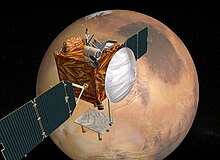Mars Telecommunications Orbiter
The Mars Telecommunications Orbiter ( MTO for short ) was planned as the first pure communications satellite to be sent on a journey to Mars . The satellite was to be built by Lockheed Martin for NASA . A launch for MTO was planned for 2009 and after about 10 months of flight it was supposed to enter a Mars orbit in September 2010 in order to transmit scientific data from space probes located on the Martian surface to Earth. The cost of the mission should be around $ 500 million. In July 2005 the mission was canceled by NASA for budget reasons.
mission
The Mars Telecommunications Orbiter was supposed to be the first Mars probe to have no scientific instruments for the exploration of Mars, but only to serve for communication between Mars and Earth. It was often referred to by NASA as the first “hub” of the interplanetary Internet . With the help of the MTO, the amount of data transmitted to earth should be increased drastically. For example, the Mars Science Laboratory can transmit 100 times as much data with the MTO as without it. In addition, the availability of the Mars Telecommunications Orbiter should free future spacecraft from the need to communicate directly with Earth. This would make the communication systems of the probes smaller and lighter, which would benefit the weight share of the scientific payload.
The Mars Telecommunications Orbiter should be the first space probe to test the possibility of communication by laser at planetary distances. The Mars Laser Communication Demonstration Project was supposed to demonstrate speeds of 10 Mbit per second, with a goal of even 30 Mbit per second.
In addition, the MTO was supposed to release a small sphere the size of a soccer ball into Mars orbit to track it up to a distance of 6,000 km. The data from this experiment should later be useful for returning Martian samples to Earth, since on such a mission the capsule with the samples in orbit must be found and intercepted in order to bring them back to Earth.
technology
The Mars Telecommunications Orbiter was expected to weigh about 2,000 kg, with most of the weight coming from the fuel needed to reach the desired orbit around Mars at 5,000 km. Since a fuel-efficient aerobraking maneuver in the atmosphere is impossible for a high orbit , the entire braking impulse of the probe would have to be applied by its engines when entering orbit.
Once in orbit, the probe would be 7 m long and, in addition to the large solar panels for generating electricity, would have an antenna about 2-3 m in size for data transmission. With this antenna, the probe should be able to communicate with NASA's Deep Space Network (DSN) in the X-band and Ka-band. Additional antennas for the UHF and X band would be mounted on a moving platform in order to communicate with probes on the Martian surface or in orbit.
Course of the mission
It was planned to launch the Mars Telecommunications Orbiter in 2009 with an Atlas V- class rocket from Cape Canaveral , which was to enter Mars orbit about 10 months later in September 2010. It should take its place on a 5,000 km high Mars orbit one month before the arrival of the Mars Science Laboratory (the start of which was to take place in 2009, then was postponed to 2011). This orbit is about 20 times as high as the orbit of a scientific Mars probe, which has to fly so low to get as close as possible to the Martian surface to be investigated. Since other priorities apply to the orbit of a communications satellite, namely to be as long as possible above the horizon when viewed from a landing site, such a high orbit was chosen for the MTO. In addition, a Mars satellite in a high orbit can be in contact with Earth almost around the clock, as it is covered by Mars much less often.
The MTO was designed for a guaranteed mission duration of six years, after which it should orbit Mars for at least another four years, sending up to 15 gigabits of data from all future Mars probes of all types and nations to Earth every day. NASA planned the launch of the next communications satellite to replace the MTO around 2018.
Later, the Mars Science and Telecommunications Orbiter (MSTO), planned for 2011 and 2013 respectively, appeared in NASA's plans, which should have taken over some of the MTO's tasks. However, MSTO was discontinued due to imprecise objective setting.
See also
Individual evidence
- ↑ Executive Summary (English)
Web links
- Information on MTO (PDF; 191 kB)


